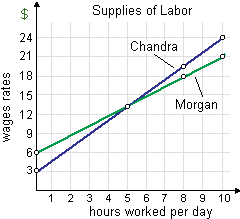When comparing such labor supplies in this illustrated figure, this is clear that the income effect of a change within wage rates is: (w) positive for Morgan and negative for Chandra. (x) more powerful than the substitution effect for both of these workers. (y) negative for both Chandra and Morgan. (z) larger, associate to the substitution effect, for Chandra than this is for Morgan.

Please choose the right answer from above...I want your suggestion for the same.